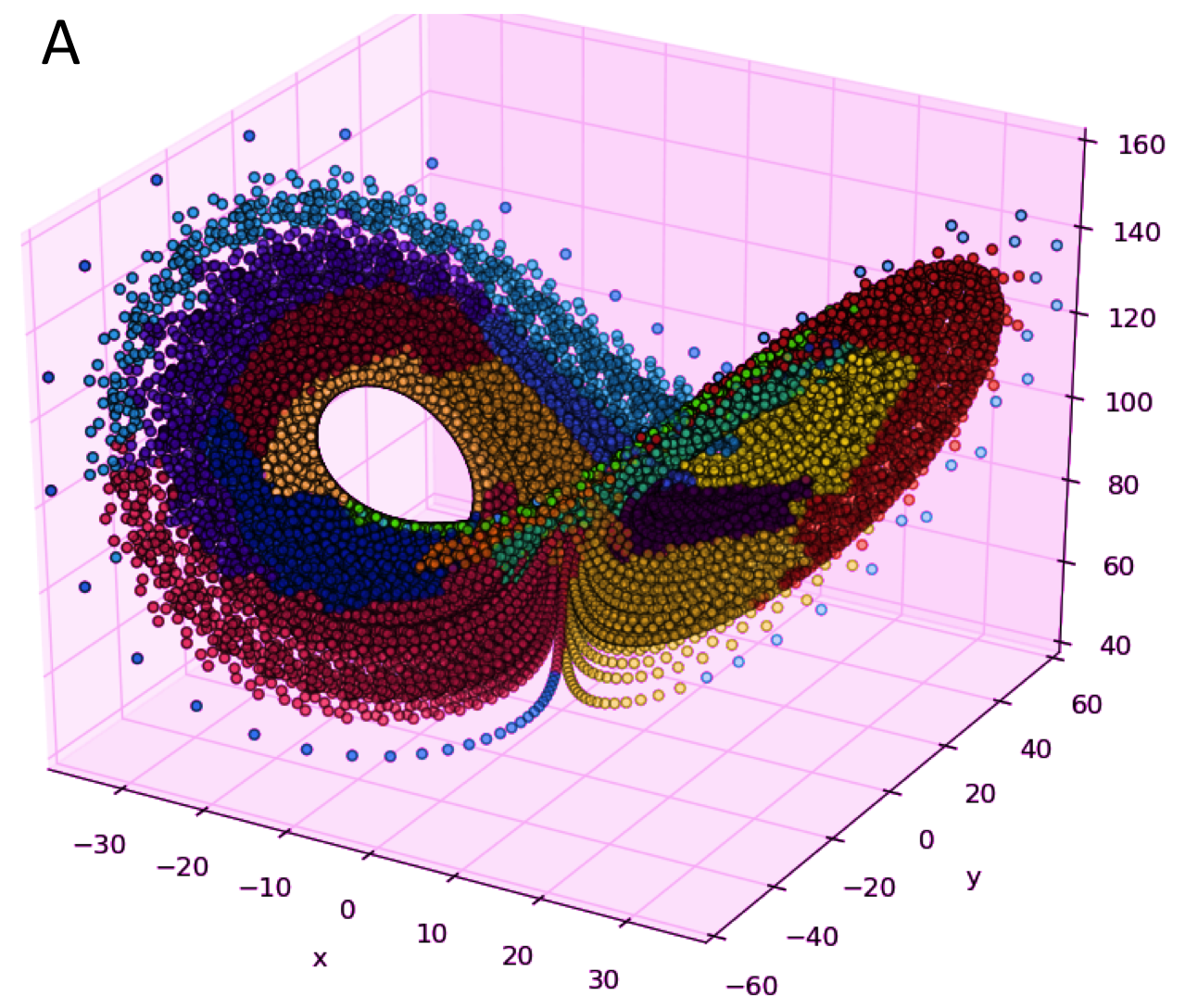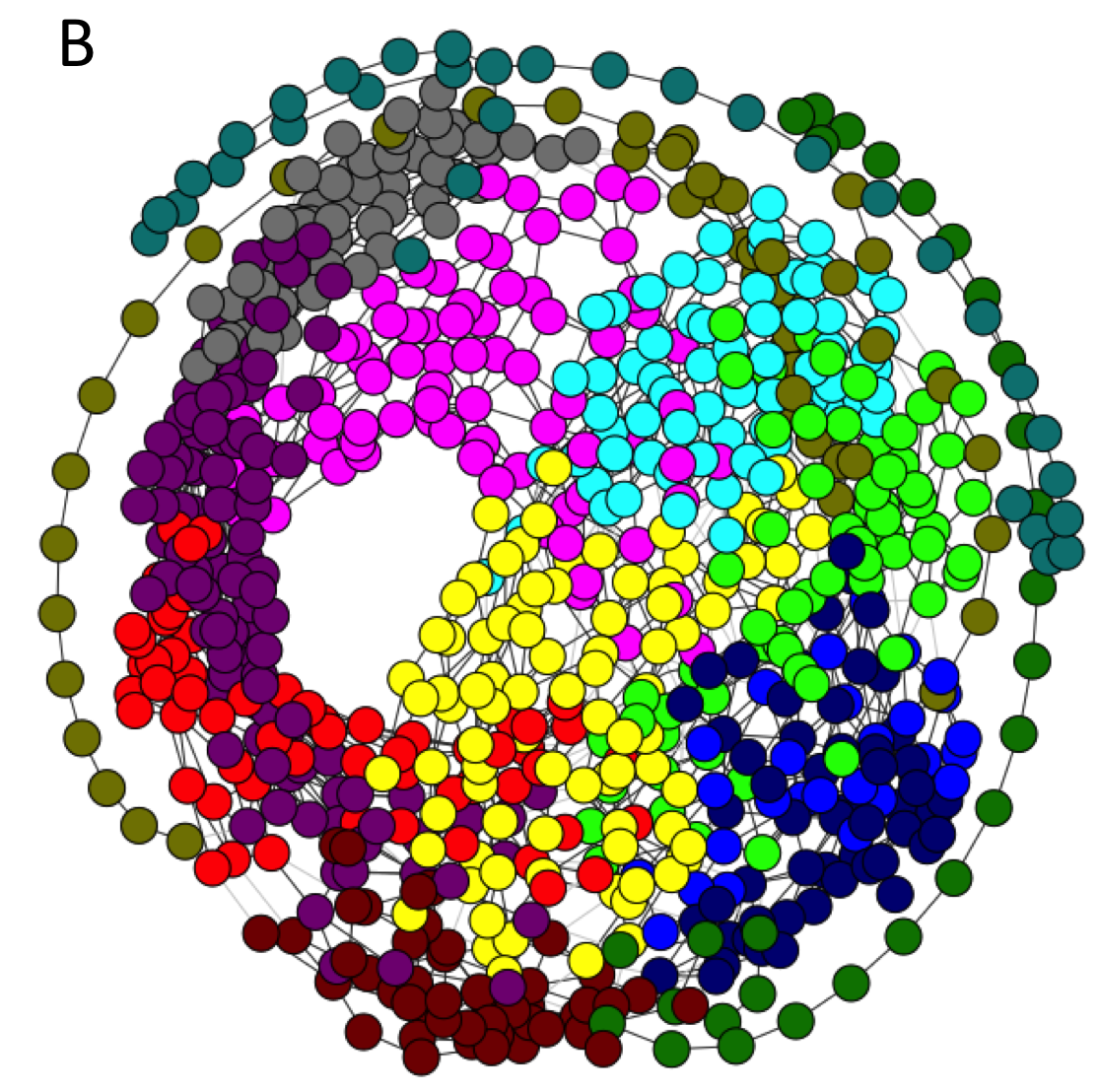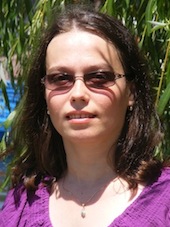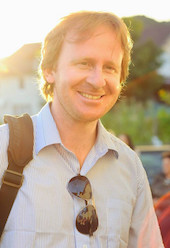

Continuous dynamical systems as state transition networks: a new perspective on brain signal analysis
Young Researchers Team Grant: PN-III-P1-1.1-TE-2016-1457
contract number: 48
Sponsored by the Romanian National Authority for Scientific Research CNCS-UEFISCDI
Project director: Dr. Mária Ercsey-Ravasz
Period: 02 May 2018- 30 April 2020
E-mail: ercsey.ravasz@phys.ubbcluj.ro
Research topic:
Nonlinear dynamics and network science are two powerful research areas with many interdisciplinary applications recently including neuroscience, where understanding brain dynamics and functional connectivity is still in its infancy. Functional networks extracted from EEG and fMRI signals have been frequently studied in the last years for understanding the neurophysiological mechanisms underlying normal and disturbed brain functions, but the low sampling rate of fMRI and the small number of electrodes in the case of EEG limits the power of this approach. In this project we aim to use state transition networks (STN) defined on continuous dynamical systems to combine the network science approach with nonlinear dynamics theory in order to study brain signals. This will lay the foundations of a method that will unleash the power of the network approach also for low dimensional data sets or even for a single time series (via time delay embedding). First, we aim to develop the methodology of extracting STNs from continuous dynamics. Studying well-known dynamical systems (Henon map, Lorenz system etc.) we want to understand how dynamical properties, such as chaotic behavior, are reflected in its structure. Second, we will apply this methodology to extract STNs from sleep EEG brain signals recorded in different clinical conditions: healthy control group, pre-manifest and manifest Huntington’s disease (a genetically inherited progressive neurodegenerative disease). Disrupted sleep being one of the earliest markers of neurodegeneration, comparing different clinical groups we want to identify potential biomarkers/predictors for cognitive decline. Our project will introduce new concepts and methods in continuous dynamics theory, will open a new direction in neuronal signal processing and can have a direct impact in clinical neuroscience, where biomarkers distinguishing normal and disturbed brain functions play a crucial role.
Aims:
Aim I: To develop the methodology of extracting state transition networks (STN) from continuous dynamics and understand how dynamical properties (such as chaotic behavior) are reflected in its structure. As a start we will work on well-known dynamical systems: Henon map, logistic map, Lorenz system etc. We will study the STN on two levels: 1) the network of states: nodes are defined as small regions of the state space divided along a geometrical grid; 2) and on a higher level, the network of modules (clusters or strongly connected subgraphs) detected in the lower-level network of states.
Aim II: To study state transition networks extracted from sleep EEG brain signals recorded in different clinical conditions. Measures offered by quantitative EEG analysis contribute essentially to the understanding of sleep physiology. We will use sleep data collected in pre-manifest and manifest Huntington's disease (a genetically inherited neurodegenerative disease). Using this methodology our goal is to identify specific patterns and discriminative features for different conditions such as different phases of sleep and health vs disease.
Progress:
Phase I (May-December 2018): Budget: 123,625 RON
Task 1.1 Studying the role of the space resolution parameter
Task 1.2 Studying the role of the time resolution parameter
Task 1.3 Studying the length and number of trajectories needed to build the STN
Task 1.4 Studying the network at a higher hierarchical level: the network of modules
Phase II (Janury-December 2019): Budget: 245,588 RON
Task 2.1 Studying STN properties of different attractors
Task 2.2 Studying properties of module networks
Task 2.3 Finding the optimal parameters to be used for extracting STN from EEG signals
Task 2.4 Comparing STNs extracted from EEG signals during different phases of sleep
Phase III (Janury-April 2020): Budget: 80,787 RON
Task 3.1 Searching for biomarkers in case of patients with early phase Huntington's disease
ISI Journal articles published during the project:
1. B Molnár, F. Molnár, M Varga, Z Toroczkai, M Ercsey-Ravasz, A continuous-time max-SAT solver with high analog performance, Nature Communications, 9, 4864, 2018, doi:10.1038/s41467-018-07327-2
2. M. Ercsey-Ravasz, “Agyi hálózatok modellezése egy távolságszabály alapján” (Modeling in- terreal cortical networks based on a distance rule), article in national journal FIRKA, ISSN: 1224-371X, vol. 27, nr.4, pp. 13-18, 2018
3. Koglin, T., Sándor, B., & Gros, C. (2019). When the goal is to generate a series of activities: A self-organized simulated robot arm. PLOS ONE, 14(6), e0217004
4. I. Toth, Zs. I. Lazar, L. Varga, F. Jarai-Szabo, I. Papp, R.V. Florian, M. Ercsey-Ravasz, Mitigating aging bias in article level metrics by citation network analysis, Scientific Reports, submitted, 2020
5. Zsolt I. Lázár, Antal Jakováac, & Péter Hantz, Analyzing the motion of symmetric tops without recurring to analytical mechanics, American Journal of Physics, submitted, 2020
6. Lázár AS, Lázár ZI, & Bódizs R., Frequency Characteristics of Sleep. In: Oxford Handbook of EEG frequencies. (in press)
7. Miriam Wandres∗, Simone Pfarr∗ , Botond Molnár∗, Ursula Schöllkopf, Maria Ercsey-Ravasz, Wolfgang H. Sommer and Christoph Körber, Alcohol and sweet reward are encoded by distinct meta-ensembles, submitted, 2020 (∗ equal contribution)
Invited talks:
M. Ercsey-Ravasz, “Az agy strukturális hálózatának modellezése” (Modeling the structural inter-areal cortical network), invited talk at the conference ”A Magyar Tudomány Napja Erdélyben” , nov. 23, 2018, Cluj-Napoca
Botond Molnár, Melinda Varga, Ferenc Molnár, Zoltán Toroczkai, Mária Ercsey-Ravasz : ”Predicting with chaos: dynamical features reveal the global optimum of NP-hard problems”, MACS 2018, 12th Joint Conference on Mathematics and Computer Science, Cluj, Sacuieu, June 14 – 17, 2018
Bulcsú Sándor, Michael Nowak, Tim Koglin, Claudius Gros : ”Dynamical systems with multiple attractors: from design to applications”, MACS 2018, 12th Joint Conference on Mathematics and Computer Science, Cluj, Sacuieu, June 14 – 17, 2018
Sándor, B. (2019), State-transition networks for encoding complex dynamics, NeuroBioTheo CADS Seminars, ITP, Goethe University, Frankfurt am Main, Germany
Ercsey-Ravasz, M., Analyzing anatomical and functional brain networks, invited talk at a Workshop at Eotvos Lorand University for Bilateral Collaboration, ELTE, Budapest, Hungary, 2019 September
Ercsey-Ravasz, M. "A conitnuous-time MaxSAT solver with high analog performance", invited talk at the Max Planck Institute in Dresden Germany, 2019 June
Sándor, B. (2019), Interactive robots as multistable dynamical systems, 1st International Symposium on Symbiotic Intelligent Systems, University of Osaka, Osaka, Japan
Sándor, B. (2019), Robofizika: alternatív paradigmák a robotikában ("Robophysics: alternativ paradigms in robotics"), MTA Testületi Ülés (Special Meeting of the Hungarian Academy of Sciences in Cluj-Napoca), Cluj-Napoca, Romania, June 14
Sándor B., Dynamical systems approach to neural dynamics and robotics, contributed talk at a Workshop at Eotvos Lorand University for Bilateral Collaboration, ELTE, Budapest, Hungary, 2019 September
Molnár B., Molnár F., Varga M., Toroczkai Z., Ercsey-Ravasz M., A continuous-time MaxSAT solver with high analog performance, Conference on Complex Systems, NTU Singapore, 2019 October
Posters:
Sándor, B., Lázár, Zs. I., Schneider, B., Ercsey-Ravasz, M. (2019) Encoding complex dynamics by state-transition networks, 44rd Conference of the Middle European Cooperation in Statistical Physics, (MECO44), LMU Munich, Kloster Seeon/Munich, Germany
S. Pfarr, M. Wandres, B. Molnár, M Ercsey-Ravasz, C. Korber, W. Sommer, cFos based network analysis reveals profound differences in the representation of memories for alcohol and sweet reward, poster at European Behavioural Pharmacology Society Biennial Meeting 2019, Braga, Portugal, 2019, August
In 2020 we submitted several posters to the MECO45 conference. These were all accepted, but the conference was delayed because of the crisis probably until September. These are the following:
Bulcsú Sándor, Schneider Bence, Zsolt I. Lázár, Mária Ercsey-Ravasz, Time-series analysis with state-transition networks, poster accepted for MECO45, 2020, Cluj-Napoca (delayed)
Bulcsú Sándor, Tim Koglin, Claudius Gros, Generating series of activities: a non-autonomous dynamical system with intermittent behavior, poster accepted for MECO45, 2020, Cluj-Napoca (delayed)
András Rusu , Lukas Schneider , Bulcsú Sándor , Claudius Gros, Complex fluctuations of a Lotka-Volterra type attention dynamics model , poster accepted for MECO45, 2020, Cluj- Napoca (delayed)
Levente Varga, Botond Molnár, Vlad V. Moca, Laura Perez-Cervera, Antonio Dıaz-Parra, David Moratal, Santiago Canals, Raul C. Muresan, and Mária Ercsey-Ravasz, Characterizing resting state brain networks based on probability distributions of network properties, poster accepted for MECO45, 2020, Cluj-Napoca (delayed)
Botond Molnár, Beáta-Ildikó Márton, Szabolcs Horvát, Mária Ercsey-Ravasz - Voronoi Diagrams to Detect Communities in Weighted Directed Graphs, poster accepted for MECO45, 2020, Cluj-Napoca (delayed)
Botond Molnár, Ferenc Molnár, Melinda Varga, Zoltán Torockai, Mária Ercsey-Ravasz - A max-SAT solver with high-performance analog dynamics, poster accepted for MECO45, 2020, Cluj-Napoca (delayed)
Other results and dissemination activities
M. Ercsey-Ravasz and B. Molnar visited Prof. Zoltan Toroczkai at the University of Notre Dame, IN, USA, between July 1-15, 2018
The project director, M. Ercsey-ravasz has obtained the QP Reward of the Hungarian Academy of Sciences, 2019 May
M. Ercsey-Ravasz, Interview at Radio Cluj, 2019 May. Project director was invited to talk about her research and results
M. Ercsey-Ravasz, Interview in the FIRKA magazine, 2019, July. FIRKA is a scientific magazine written for high-school students. The project director was talking about her career, main research areas and important achievements
Other publications:
- M. Ercsey-Ravasz, "Agyi halozaok modellezese egy tavolsagszabaly alapjan" ("Modeling structural brain networks based on a distance rule"), FIRKA, invited paper 2017-2018 vol. 4 (emt.ro)
Previous publications relevant to the project:
- Răzvan Gămănuţ, Henry Kennedy, Zoltán Toroczkai, Mária Ercsey-Ravasz, David C Van Essen, Kenneth Knoblauch, Andreas Burkhalter, The Mouse Cortical Connectome, Characterized by an Ultra-Dense Cortical Graph, Maintains Specificity by Distinct Connectivity Profiles, Neuron 97, 698-715. e10 , 2018.
- Xunzhao Yin, Behnam Sedighi, Melinda Varga, Mária Ercsey-Ravasz, Zoltán Toroczkai, Xiaobo Sharon Hu, „Efficient analog circuits for Boolean satisfiability”, IEEE Transactions on Very Large Scale Integration (VLSI) Systems, vol. 26 (1), pp. 155-167, 2018.
- Sz. Horvát†, Răzvan Gămănuț†, Mária Ercsey-Ravasz†, Loïc Magrou, Bianca Gămănuț, David C. Van Essen, Andreas Burkhalter, Kenneth Knoblauch, Zoltán Toroczkai, Henry Kennedy,”Spatial embedding and wiring cost constrain the functional layout of cortical networks in rodents and primates”, PLoS Biol., vol. 14, e1002512, 2016. († indicates equal contribution).
- M. Ercsey-Ravasz, N.T. Markov, C. Lamy, D.C. Van Essen, K. Knoblauch, Z. Toroczkai, H. Kennedy, “A predictive network model of cerebral cortical connectivity based on a distance rule.”, Neuron vol. 80, pp. 184-197, 2013
- N.T. Markov, M. Ercsey-Ravasz, D.C. Van Essen, K. Knoblauch, Z. Toroczkai, H. Kennedy, "Cortical High-density Counter-stream Architectures", Science, 342, 1238406, 2013 doi:10.1126/science.1238406
- M. Ercsey-Ravasz, Z. Toroczkai, "The Chaos Within Sudoku", Nature Scientific Reports 2, 755 (2012) doi:10.1038/srep00725
- M. Ercsey-Ravasz, Z. Toroczkai, "Optimization Hardness as Transient Chaos in an Analog Approach to Constraint Satisfaction", Nature Physics 7, 966 (2011) arxiv:1208.0526
Research group

Dr. Mária Ercsey-Ravasz
Project director
After obtaining Ph.D. in Physics and Information Technology, Dr. Ercsey-Ravasz have spent 3 years as a postdoctoral researcher at the University of Notre Dame, IN, USA. She returned to Romania to the Babes-Bolyai University with a Marie Curie Fellowship in 2012.
homepage



